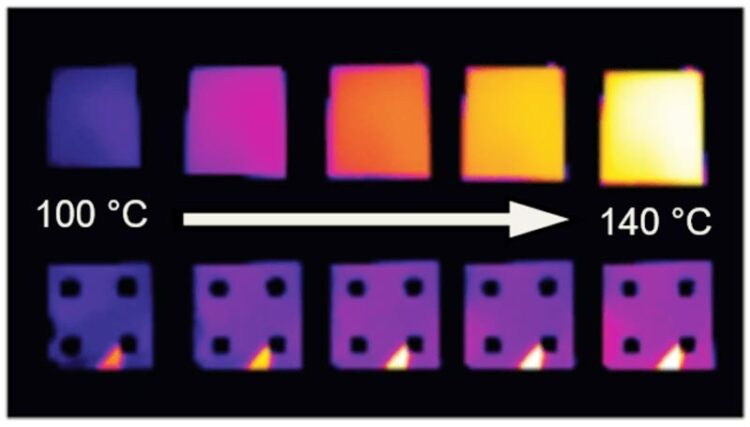Quantum materials cloak thermal radiation

Thermal images of samples heated from 100 to 140 degrees C. The top row shows a material heating with increasing temperature. The bottom row shows the same material coated with ultrathin samarium nickel oxide films that cloak the thermal emission.
Image courtesy of paper author A. Shahsafi, University of Wisconsin-Madison
A unique coating camouflages the temperature of an underlying material.
The Science
Scientists demonstrated that ultrathin films of samarium nickel oxide can mask the thermal radiation emitted by hot materials. Samarium nickel oxide is a quantum material. These are materials that have strange and incredible properties due to quantum mechanics. The cloaking mechanism is due to the material undergoing a unique, gradual transition from insulator to heat-conducting metal. This transition occurs over a temperature range from 100 to 140 degrees centigrade.
The Impact
This study shows that quantum materials can manage thermal radiation. This ability could advance applications such as infrared camouflage, privacy shielding, and heat transfer control. The 100-140 degree centigrade heat range is important because it can be seen with infrared cameras.
Summary
Conventional wisdom states that the hotter an object is, the brighter it glows. This is the case for thermal light at any wavelength and enables applications such as infrared imaging and noncontact thermometry. However, researchers at the Department of Energy (DOE) Center for Functional Nanomaterials at Brookhaven National Laboratory demonstrated a coating that emits the same amount of thermal radiation regardless of temperature, within a temperature range of about 30 degrees centigrade. This is accomplished using samarium nickel oxide—a quantum material that changes strongly but gradually as a function of temperature. This is the first time researchers have demonstrated temperature-independent thermal radiation. The results have substantial implications for infrared camouflage, privacy shielding, and radiative heat transfer.
Funding
This research was supported by Office of Naval and the National Science Foundation, the Air Force Office of Scientific Research, and a Critical Skills Master’s Fellowship from Sandia National Laboratories. Some measurements were performed at the Soft Materials Characterization Laboratory at the University of Wisconsin–Madison. This research used resources of the Center for Functional Nanomaterials and National Synchrotron Light Source II, both of which are DOE Office of Science user facilities at Brookhaven National Laboratory.
DOI: https://doi.org/10.1073/pnas.1911244116
Method of Research: Experimental study
Article Title: Temperature-independent thermal radiation
Article Publication Date: 17-Dec-2019
Media Contact
Michael Church
michael.church@science.doe.gov
Office: 505-358-1481
All latest news from the category: Materials Sciences
Materials management deals with the research, development, manufacturing and processing of raw and industrial materials. Key aspects here are biological and medical issues, which play an increasingly important role in this field.
innovations-report offers in-depth articles related to the development and application of materials and the structure and properties of new materials.
Newest articles

Innovative 3D printed scaffolds offer new hope for bone healing
Researchers at the Institute for Bioengineering of Catalonia have developed novel 3D printed PLA-CaP scaffolds that promote blood vessel formation, ensuring better healing and regeneration of bone tissue. Bone is…

The surprising role of gut infection in Alzheimer’s disease
ASU- and Banner Alzheimer’s Institute-led study implicates link between a common virus and the disease, which travels from the gut to the brain and may be a target for antiviral…

Molecular gardening: New enzymes discovered for protein modification pruning
How deubiquitinases USP53 and USP54 cleave long polyubiquitin chains and how the former is linked to liver disease in children. Deubiquitinases (DUBs) are enzymes used by cells to trim protein…



